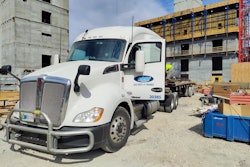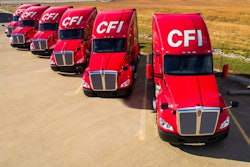Jury awards exceeding $10 million, known as nuclear verdicts, are on the rise in the trucking industry – and those decisions are making it tougher for transportation companies to stay in business.
According to a 2020 report from the American Transportation Research Institute (ATRI), average verdicts in the U.S. trucking industry soared from just over $2.3 million to nearly $22.3 million between 2010 and 2018 – a 967% increase – and these settlements are still spiking after courts started reopening following COVID-related shutdowns.

Want to know the secret to lowering insurance costs? It's driver data.
Do you know which drivers are causing your insurance rates to soar? What small driver management changes can you make that will pay off big in reduced risks and lower insurance costs? With decades of experience in the transportation insurance market, experts from the Central Analysis Bureau will use their deep data analysis to show carriers what insurers are looking for and demonstrate steps they can take to keep premiums down and avoid nuclear verdicts.
Join us in person at the the 2021 CCJ Solutions Summit, Nov. 30 - Dec. 2, in Chandler, Arizona. CCJ Summit assembles fleet executives, thought leaders, industry analysts and leading suppliers to explore ways equipment, technology and corporate culture can shift the driver paradigm and overcome your No. 1 challenge: Cultivating a qualified workforce.
Don’t miss your chance to collaborate and socialize in-person with your peers at the picturesque Sheraton Grand at Wild Horse Pass.
When companies face a judgement exceeding their insurance limits, it results in higher prices for liability insurance coverage, increased consolidation of larger companies absorbing smaller businesses, and it increases the odds that companies either go bankrupt or are forced to sell.
This trend is also fueling higher prices for Truckers Auto Liability Insurance and reducing access to Excess Liability Insurance – two critical types of coverage because of the severity of many trucking accidents. When these market changes occur, some operations are forced to close, leaving many in the industry worrying how a single, severe loss could potentially impact their bottom line. These upward trends align with an increase in fatal trucking accidents, with the National Safety Council reporting a 43% increase in deadly crashes involving large trucks between 2010 and 2019. If companies don’t have high enough insurance limits they risk losing their business, and the judgement will have to be paid one way or another. As these types of insurances become less affordable, we’ll see more companies go out of business, leading to more consolidation across the industry.
Trucking companies need higher limits to meet rising verdicts
In Canada, truckers typically carry CAD$1 million limits – and those that cross into the U.S. tend to have about CAD$2 million in coverage. Meanwhile, American federal law mandates truckers must carry at least $750,000 in liability insurance, though many insurance carriers issue $1 million limits. In fact, there’s a push to increase those limits to more than $2 million, and with good reason.
In August 2021, a jury ordered a $1 billion verdict against two trucking companies for a crash resulting in the death of a University of North Florida student that occurred near Jacksonville in 2017. In October 2020, another jury in Florida ordered a trucking company to pay $411 million to a motorcyclist injured in a 45-vehicle pileup — a verdict that reportedly could be the largest ever against a single-company defendant.
Trucking operators also need Physical Damage Insurance, which protects the truck itself in an accident and could help pay for the cost to repair or replace the vehicle. Cargo Insurance, meanwhile, covers damage done to goods being hauled by a trucker.
Challenging insurance landscape puts smaller operations at greater risk
While larger trucking companies may be able to absorb the rising cost of insurance, smaller and mid-sized operations may struggle and ultimately pass these costs onto their customers. For smaller operators, it’s more about cost than it is about availability.
These companies also have less financial flexibility and the most trouble accessing large enough Excess Liability Insurance limits – meaning insurance carriers are usually less willing to take on “large chunks of limit,” which makes it a challenge to piece together enough coverage. Excess Liability Insurance capacity is usually available for limits up to $5 million, but right now the cost for those limits continues to rise because the losses are penetrating those layers relatively easily today.
Social inflation and the increased use of litigation financing are also contributing to rising nuclear verdicts and more difficulties for smaller operators. Joint liability also plays a role, and trucking companies could ultimately pay a greater share of accidents costs, despite being only partially at fault.
Given these challenges, smaller trucking companies may opt to “just risk it” and to forgo adequate insurance limits because they are unaffordable. But if a nuclear judgment is handed down that exceeds the company’s insurance limits, it could cause the organization to go bankrupt or force it to sell the firm to meet a judgement.
It is a disconcerting trend, considering more than 70% of all cargo transported in the U.S. (and over 60% in Canada) is moved by trucks — a figure expected to continue to grow in the future. Ultimately, the ones that will not be able to afford the premiums will be the smaller, family-owned, 10-unit-and-less companies.
Strict driver requirements, new vehicle technology can aid in risk management
In both the U.S. and Canada, trucking companies are contending with a shortage of qualified truck drivers. Despite this challenge, it’s critical companies maintain high standards for hiring qualified experienced drivers. If someone is hired despite not meeting acceptable, written criteria, those factors can be used against a driver during a trial.
New vehicle technology, including dash cams and telematics systems, can be another key risk management tool. In fact, these devices may become a requirement for Truckers Auto Liability Insurance in the future. With the use of telematics, there will be more data-driven decisions in the insurance purchasing process and that data, as well as driver behavior and hiring practices, will continue to be used as time goes on.
Trucking companies navigating the shifting marketplace for Transportation Insurance should know that their individual insurance needs will vary based on their operations. Pollutant releases, for example, are not generally covered by Truckers Auto Liability Insurance and are a considerable risk for many truckers. In 2019, a trucking company in Texas was fined $12,500 for a semi-truck accident that caused 1,000 gallons of ammonium lauryl sulfate to spill into a creek, leading to a major fish kill.
Unless companies have a separate Transportation Pollution Liability Insurance policy, a pollution release is typically not covered. Truckers Auto Liability Insurance can provide coverage for fluids that are released from the vehicle.
An experienced Transportation Insurance broker can assist trucking operators by assessing their risk exposure and providing access to the insurance markets needed. They will know how to position the operator’s information to a carrier in order to get the most comprehensive and competitive package. Brokers and carriers can work together to help the operator secure competitive proposals, including education on how to meet underwriter requirements and industry-wide best practices, such as the implementation of loss mitigation technologies.
Burns & Wilcox is the insurance industry's leading wholesale insurance broker and underwriting manager internationally recognized for its expertise in commercial and professional liability, property, environmental, marine and personal insurance. Burns & Wilcox is a member of H.W. Kaufman Group, which has over 60 offices across the United States, Canada, and Europe and employs more than 2,000 professionals.











